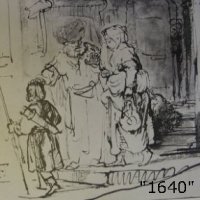Written by Nigel Konstam
Edited by Nancy Grossman-Telfer
Recently Rembrandt scholars have reduced the number of drawings and paintings that they accept as being by Rembrandt by between 50% and 70%. A massive change of opinion from scholars in the past. Why has this happened and where does the truth lie? I have studied this problem for over 35 years. I have come to the conclusion that we are dismissing works that are truly by Rembrandt because of a misunderstanding of his character as an artist.
Rembrandt was an observer; not an inventor. He was not able to draw from his imagination. This may seem strange to us today: such a great master, unable to draw from his head? However, when he tried to do so; his works whether paintings or drawings, suffered drastically. A discovery published in 1977 makes it clear that Rembrandt normally worked direct from life using groups of models for his biblical and mythological subjects.He also worked from mirror reflections of these groups. The drawings done from mirror images are of a lesser quality then those done direct from life. While the works, or parts of works he made up/drew from imagination, are of a recognisably different quality again.
The Spectrum of Quality We Can Expect from Rembrandt
When Rembrandt is responding to life directly we can hope to see the individual character clearly and a vivid transaction taking place between the characters in a precisely defined and psychologically telling space. This is Rembrandt's main interest and his supreme gift. When he draws from a dimmer stimulus the mirror, these qualities are very much reduced. See the Hagar sketches where the relationship between the figures is more or less reduced to the flat pattern of the shapes as perceived in the mirror. When he draws from imagination the differences should be clear even on the computer screen.
***********************
These three modes of working produced results that are easily distinguishable from one another, once the differences are pointed out. The scholars have tried to account for these differences in Rembrandt's drawings by theorising that they were done at different periods of Rembrandt's life and done solely from Rembrandt's imagination. However, in many cases the drawings done from live model groups match up perfectly (see illustrations below) with the mirror image drawings. This strongly suggests that these works were all done at the same time, using the same group of models observed from the same (Rembrandt's) position in his studio. The differences in the quality of Rembrandt's drawings drawn direct from life, (or less satisfactorily from mirror images or from Rembrandt's imagination) presents us with a much wider spectrum of what to expect from Rembrandt: his work is extraordinarily variable. This spectrum concept is much more credible than the scholars' theory. It can be observed in many artists' work: for instance, Leonardo or Cezanne.

Further good examples of Rembrandt's attempts to draw from imagination are his drawing of flying angels - no models available obviously!
***********************
The Rembrandt Research Project has suggested that Rembrandt had a workshop with assistants. Most of the deattributed drawings and paintings have been said to be done by these assistants rather than Rembrandt. However, there is no real evidence that Rembrandt had such a workshop; nor had it ever been suggested by Rembrandt's contemporaries or scholars before 1969. If we are to reinstate Rembrandt's art it is important to understand how recent and how ill-supported the concept of Rembrandt's workshop is.
The characteristics of how Rembrandt worked, his insistence on observing nature, are well documented by Rembrandt's contemporaries. Arnold Houbraken wrote in 1718 "[Rembrandt] was indeed faithful to the principle that one must follow only nature: anything else was worthless in his eyes". When this view is accepted by our experts, it will lead to the re-attribution of the vast majority of Rembrandt's works- both paintings and drawings that have been recently deattributed.
Through the website we see that Rembrandt created works that were sometimes flawed. We see a more human Rembrandt, a master we can learn from. One can understand why the scholars in the past have shied away from this image of Rembrandt. He seems so far removed from the great artists of the Renaissance, but why is it we are still suffering from this misunderstanding of his true artistic character today?
After my lectures at the Slade, the Slade Professor Sir Lawrence Gowing wrote to me "I find your view of the division between objective and imaginative seems to me, artistically and psychologically, much more comprehensible and satisfactory than anything before" - Lawrence Gowing
We will continue to work to reinstate Rembrandt's art. We hope this website has been a tool for you in understanding about this great master. If you would like to further this cause please recommend this website. We would appreciate feedback through the discussion forum.
SEEING IS BELIEVING - All these models and mirrors can be viewed by appointment at the Verrocchio Arts Centre








